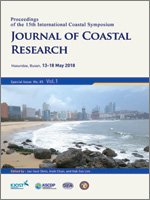Kim, H.; Heo, K.-Y.; Kwon, J.-I., and Park, K.-S., 2018. Simulation of typhoon Chaba over Korean Peninsula using HWRF modeling system. In: Shim, J.-S.; Chun, I., and Lim, H.S. (eds.), Proceedings from the International Coastal Symposium (ICS) 2018 (Busan, Republic of Korea). Journal of Coastal Research, Special Issue No. 85, pp. 751–755. Coconut Creek (Florida), ISSN 0749-0208.
Forecasting the intensity and track of typhoons is a complex and challenging problem. In this study, the Hurricane Weather Research and Forecasting (HWRF) system and Weather Research and Forecasting (WRF) was employed to improve the forecasting efficiency for typhoon track and intensity. A comparison analysis was performed between the HWRF and WRF systems using data from observational buoys in the southern part of the Korean Peninsula (KP). The HWRF model could capture typhoon Chaba's track after landfall better than the WRF model. With respect to the intensity, the HWRF model overestimated the maximum wind speed and central sea level pressure while the WRF model underestimated it. These results indicate that the HWRF model was superior to the WRF one for predicting the characteristics of typhoon Chaba after landfall. Further, the HWRF model is suitable for predicting typhoon induced high waves and surges over KP.





